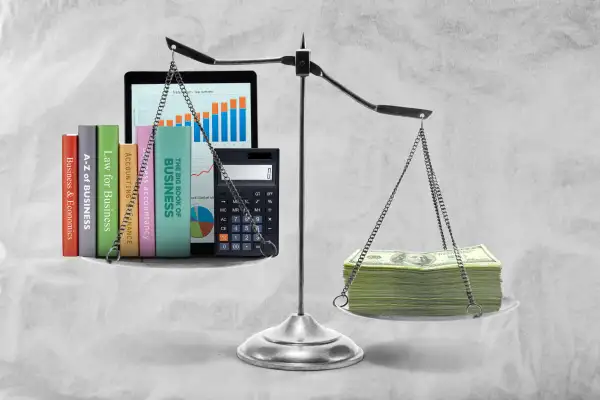MBA Debt: Here's How Much You'll Have to Borrow to Go to Business School

If you want to boost your earning potential, switch industries, or sharpen your entrepreneurial skills, a master’s of business administration, or “MBA,” can help you do just that.
But MBAs don’t come cheap. Data from the National Center of Education Statistics show that more than half of MBA students take on student debt to finance their degree. The average student loan balance for graduates was $66,300 in 2016 — a number that has continued to increase, according to more recent reports.
MBA holders are also among the nation’s top earners. However, not every MBA grad commands a six-figure salary. Earnings fluctuate depending on your location and the industry you work in, which means the difficulty of paying off tens of thousands of dollars of debt will also vary.
Here’s what you should know about MBAs and student debt.
How Much Do MBAs Cost?
Applications to MBA programs increased in 2020, partly due to the pandemic recession. But that’s a reversal of what’s happened in the past several years, where applications have slowed as the high cost of business school, coupled with doubts about the value of an MBA, among other factors, drove some applicants away.
Stacey Koprince, lead of content and curriculum at Manhattan Prep, a test preparation agency, says that one of the reasons why business school is so expensive is because of the people teaching the courses.
“If you want to have professors who are not just academics, but who are actually in the business world themselves, then you're gonna have to pay the kinds of salaries that they could be making if they were out running a business themselves,” Koprince says.
Business schools also spend large amounts on resources to help students with career placement, says Barbara Coward, a consultant at MBA 360 Admissions. That includes networking summits (sometimes out of town), seminars and individual counselors — all of which are rolled up into the programs’ overall cost.
So, how much does it cost to get an MBA? Here’s the average cost of tuition and fees for full-time residential programs by residency status, according to data provided by the Association to Advance Collegiate Schools of Business (AACSB):
- Resident students: $41,793
- Nonresident students: $52,696
But tuition and fees are just the tip of the iceberg. The cost of relocation, books, supplies, and other miscellaneous expenses can set you back several thousand dollars more.
How Much You’ll Need to Borrow for an MBA
The average MBA graduate that borrowed money for school has close to $75,000 in student loans, according to a 2018 report from SoFi, an online lender. The report analyzed data from over 60,000 student loan refinancing applications and also found that, in some cases, MBA students leave school with as much as $151,000 in debt.
But how much you’ll need to borrow will depend on a few factors, including the program’s format, your residency status, and how prestigious it is.
As previously discussed, students who attend a full-time residential program in their state pay an average of $41,793 in tuition and fees vs $52,696, which is the average cost for nonresident students, according to data from the AACSB. If you attend a full-time online program, however, these numbers can drop by several thousand dollars more to an average of $34,889.
As for prestige, a program at a top 10 school can cost over $80,000 a year in tuition alone, while a good MBA program at a less selective but still competitive school can cost around $58,000.
Linda Abraham, CEO of Accepted, a college admissions consulting company, says that another factor that will dictate how much you’ll borrow is the program’s location. “If you choose a school in a high cost of living area, your cost is going to be higher, so you’ll need more” Abraham says.
Types of Loans You Can Use for an MBA
As an MBA student, you’ll have three lending options: federal loans, institutional loans, and private loans.
When borrowing money for school, federal loans should be your first choice. They offer lower interest rates than most institutional and private loans, plus more flexible repayment options.
MBA students can apply for two types of federal loans: Direct Unsubsidized loans and Grad PLUS loans, both of which require you to fill out the Free Application for Federal Student Aid (FAFSA).
Approval for Direct Unsubsidized loans doesn’t require that you pass a credit check. To qualify, you just need to be in good academic standing and enrolled in school at least part-time. They currently have a fixed interest rate of 4.30% and a $20,500 annual limit for graduate students.
Grad PLUS loans currently have a fixed interest rate of 5.30% and can be taken out for the full cost of attendance. But because they offer higher borrowing limits, they do require you to pass a simple credit check to be approved for the loan. Both Direct Unsubsidized and Grad PLUS loans don’t require you to start making any payments until six months after you graduate.
Institutional loans are provided by the school. These are available to bridge the financial gap once you’ve maxed out scholarships, grants, and federal student loans. The eligibility requirements, borrowing limits, terms and conditions are set by each school, so these vary from one institution to the next. However, they tend to offer lower interest rates and more flexible repayment options than private loans.
Private loans should be your last resort. They work similarly to personal loans in the sense that you’ll have to pass a credit check to be approved for the loan and the interest rate will be based on your creditworthiness. The only difference is that with a private loan you’re not required to start making payments while in school.
Private loans can have fixed or variable interest rates that can be as low as 1.25% or as high as 15%. But to get the lowest rates, you must have a stable source of income and excellent credit or have a co-signer that meets these standards.
Tips to Minimize Debt When Pursuing an MBA
Finishing your MBA debt-free may be a tall order, but there are a few things you can do to reduce the amount you borrow.
For some students, debt starts before they’re even admitted into a program. Koprince, from Manhattan Prep, says that the application process alone can set students back a few thousand dollars. Costs at this phase include test preparation services, hiring an admissions consultant, and the schools’ application fees.
Although some of these services are optional, most students decide to pay for them in hopes of increasing their chances of getting into a good program, especially now that competition is steep due to a surge in applications.
One way to mitigate these costs is by narrowing down the list of schools where you apply. “You usually have to pay just for the privilege of applying to the schools, and so for that reason, you don't want to just apply indiscriminately to 20 schools,” Koprince says.
Additionally, some test preparation agencies offer scholarships or tuition assistance programs that can cover the full cost of a test prep package. The requirements vary by agency, but you’ll usually be asked to provide your GPA or resume, and a short explanation of why you’d benefit from the program.
Abraham, from Accepted, says that another way to reduce your expenses is by attending a program that’s in a lower cost of living area, rather than attending one that’s in an expensive place like New York or the Bay Area.
Business schools typically offer military tuition discounts, grants, scholarships, fellowships, and other forms of aid to students, which is why Abraham also recommends applicants not just look at the sticker price but at how much aid you can get. “You never really know how much an MBA will cost you until you’re accepted,” Abraham says. “We are seeing more of our clients getting scholarships and getting larger ones,” she adds.
However, Esther Magna, an MBA admissions consultant at Stacy Blackman Consulting, says that MBA scholarships are usually merit-based or given to the most desirable candidates, which is why it’s important to make a compelling case when you apply.
You can also explore part-time or online programs as these tend to be more affordable than full-time residential ones, plus you’ll have the opportunity to keep earning money while in school. “If you can handle the grind of working full-time and going to school part-time, these are definitely less expensive options,” Abraham says.
Besides that, some employers offer tuition assistance or other forms of sponsorship for students who wish to further their careers by getting an MBA. Still, these do come with strings attached, so Abraham says to only pursue them if you’re not thinking about switching jobs right after you graduate.
Debt Repayment Strategies
If you have federal loans, you won’t be required to start making any payments until six months after you graduate. With private loans, this grace period is determined by the lender, so it may vary.
As previously mentioned, one of the benefits of having federal loans over private ones is that federal loans offer income-driven repayment options. With an income-driven plan, payments are based on how much you earn, which can result in lower monthly payments if your salary is low relative to your debt.
If you’re employed by a government agency, non-profit institution, or another qualifying employer, you’ll also be able to apply for the Public Service Loan Forgiveness (PSLF) program. Under PSLF, you’re required to make payments toward your federal loans for ten years. After that, the remaining balance is forgiven.
Additionally, some schools offer loan repayment assistance programs for graduates who are working in the public sector, government, or other lower-paying fields, under which you could also get an annual stipend to go toward your loan balance.
But if you’re an MBA graduate working in a high-paying job, your priorities may be less about reducing your monthly payments rather than paying off your debt as quickly as possible. If that’s the case, you may want to consider refinancing your debt. While you’d give up access to important federal protections (like income-driven repayment), you can access a much lower interest rate if you have excellent credit and a stable source of income.
For example, let’s say you have $75,000 worth of student loans with a 6% interest rate and a 10-year repayment term. With that loan, your monthly payments would total $833, and you’d end up paying roughly $24,900 worth of interest over the life of the loan.
If you refinance that same loan amount with a 6-year term and a 4% interest rate, your monthly payments would be slightly more, at about $915, but you’d pay only $12,000 worth of interest.
More from Money:
Is Going to Grad School a Good Financial Decision During a Recession?
Federal Student Loan Forgiveness Programs Already Exist. Why Aren't More Borrowers Taking Advantage?
You Can Deduct Student Loan Interest on Your 2020 Taxes Even if You Skipped Payments Last Year
